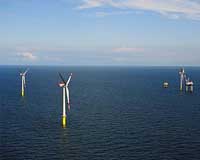 |
Geesthacht, Germany (SPX) Aug 17, 2009 Scientists of the Geesthacht GKSS Research Centre have developed a radar system with which it is possible to study the behaviour of sea waves. This technology will be used immediately on the North Sea on the FINO3 research platform in order to determine the interactions between offshore wind power machines and swells. The location of the FINO3 research platforms, the "Dan Tysk" sand bank, is located approximately 80 kilometres to the west of Sylt where up to 80 wind power plants will be located in just a few years. FINO3 is used by researchers to estimate the environmental consequences and technical risks of offshore wind energy parks. Changes in the sea swell are also of great interest in addition to the observations of bird migration or the measurement of lightening frequencies on the sea. To determine how much of an effect large waves and what is known as 'breakers' have on wind power plants and to what extent the structures can change the surrounding swell, the coastal researchers of the Geesthacht GKSS Research Centre installed a Doppler radar approximately 50 metres above sea level on the FINO3 lattice mast. "With our radar, we can even track the individual waves for the first time", writes Dr. Freidwart Ziemer, GKSS Department Manager of Radar Hydrology, the unique part of the project. For several years, Ziemer and his team have studied the swell and the behaviour of large breakers. The information is transmitted by FINO3 to Geesthacht via satellite.
Assessing swells better Each individual wind rotor creates turbulent air flows in its "tow" and periodical movements, which can have an effect on other structures. This can result in undesired or even dangerous vibrations. If there is an interaction between the waves and the individual wind power plants, this can result in interferences. This means in a wave field which is harmless without a windmill park, single, very high waves can be created by these interferences which could possibly have a critical effect on these plants. "I am sure that we will soon be able to better assess the swells and the force of the breakers," says Friedwart Ziemer. This means that the breaker behaviour could be taken into account better in planning and the stability of the systems can be more predictable.
Solid position on the COSYNA North Sea monitoring system FINO3 will provide the Geesthacht coast researchers information on seafaring and the wind. Breaker statistics are also planned. The Doppler radar technology was developed by the GKSS employees in unison with the Technical University of Saint Petersburg. The initial test readings with the new wave radar from the shore have already been carried out successfully. The project coordinator of FINO3 is the research and development centre of the Kiel University of Applied Sciences (Fachhochschule Kiel GmbH). The project executing organisation is the Federal ministry of the environment, natural protection and reactor safety (BMU). Share This Article With Planet Earth
Related Links Geesthacht GKSS Research Centre Wind Energy News at Wind Daily
 First German offshore wind farm online
First German offshore wind farm onlineBremerhaven, Germany (UPI) Aug 14, 2009 A year late and roughly $85 million over budget, Germany's first offshore wind farm Alpha Ventus has now gone online. The first three of the farm's 12 5MW wind turbines began supplying electricity to the national grid Wednesday, the company said. Towering 328 feet above the rocky North Sea, they represent Germany's hopes for clean power generation from sea-born wind. The remaining nine ... read more |
|
| The content herein, unless otherwise known to be public domain, are Copyright 1995-2009 - SpaceDaily. AFP and UPI Wire Stories are copyright Agence France-Presse and United Press International. ESA Portal Reports are copyright European Space Agency. All NASA sourced material is public domain. Additional copyrights may apply in whole or part to other bona fide parties. Advertising does not imply endorsement,agreement or approval of any opinions, statements or information provided by SpaceDaily on any Web page published or hosted by SpaceDaily. Privacy Statement |